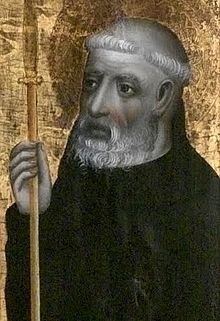Procopius of Sázava

Prokop von Sázava (* around 970 in Chotouň, today part of Chrášťany in Okres Kolín ; † March 25, 1053 in Sázava ) was a priest and the founder of the Sázava monastery in Bohemia . He is one of the Bohemian national patrons . Prokop is venerated as a saint in the Roman Catholic Church . His feast day is June 4th .
Life
Prokop was born at the end of the 10th century in Chotouň, a small town in Central Bohemia near the town of Kouřim . The year of birth 970 given by later sources is unsecured. He mastered the Slavic Glagolitic script and, according to legends, worked as a priest. Prokop was married and had a son named Jimram (Emmeram).
After turning away from worldly life, Prokop first became a monk, probably in the Benedictine monastery Břevnov near Prague, and later a hermit in a cave on the central reaches of the Sázava River . Little by little, a small monastic settlement developed around his cell and finally a monastery in 1032, which accepted the Benedictine order. Prince Břetislav I confirmed the foundation and appointed the hermit as the first abbot. Prokop exercised this function until his death on March 25, 1053. Prokop's pupils also included his son Jimram and his nephew Veith, who both later became his successors as abbots of Sasau.
Adoration
The oldest testimony to Prokop's life, the Vita Minor ( Little St. Prokop legend ) was possibly written in the Old Church Slavonic language .
In 1056 the monks had to leave the Sázava monastery for the first time. In 1096 they were finally expelled. The monastery was taken over by monks from Břevnov, who followed the Latin rite, but kept the memory of the founder high.
In 1204 Prokop was given to Pope Innocent III. canonized. He was the first Bohemian saint to be canonized in Rome.
Its cult took on a particular boom under Emperor Charles IV in the 15th century. Between 1547 and 1593 he gave the Emmaus Monastery in Prague a manuscript in Old Slavonic in Cyrillic script , the so-called Reims Evangelistar . This should supposedly be written by Prokop. However, the Cyrillic script was never used in Bohemia. The Emmaus monks added a Glagolitic part to the manuscript and combined both works into a splendidly decorated book.
In 1588 Prokop's remains were transferred to Prague and buried in the All Saints Church at Prague Castle . As a result, poems, hagiographical and homiletic works of Prokop worship were created.

Over 100 churches were dedicated to the saint . Valuable Prokop statues and paintings date from the Baroque period . In the 19th century he became the patron saint of Czech emigrants overseas; Procopius churches were organized in Chicago , Cleveland, and Dakota. Well-known modern literary adaptations of the Prokop legend were created by the poets Jaroslav Vrchlický and Vítězslav Nezval .
literature
- Jaroslav Kadlec: St. Procopius . In: A thousand years of Benedictines in the monasteries of Břevnov, Braunau and Rohr. EOS Verlag Erzabtei St. Ottilien 1993, ISSN 0303-4224 , pp. 309-324.
- Ekkart Sauser : Prokop of Sázava. In: Biographisch-Bibliographisches Kirchenlexikon (BBKL). Volume 22, Bautz, Nordhausen 2003, ISBN 3-88309-133-2 , Sp. 1122-1123.
- Petr Sommer: (Ed.): The holy Prokop. Bohemia and Central Europe. International Symposium Benešov - Sázava, 24. – 26. September 2003 (= Colloquia mediaevalia Pragensia. Vol. 4.), Prague 2005
Web links
Remarks
- ↑ But the Glagolitic script, cf. Prague leaves from the Sázava monastery
- ↑ Jaroslav Kadlec: The Monastery of St. Prokop on the Sasau . In: A thousand years of Benedictines in the monasteries of Břevnov, Braunau and Rohr. EOS Verlag Erzabtei St. Ottilien 1993, ISSN 0303-4224 , pp. 297-307.
| personal data | |
|---|---|
| SURNAME | Procopius of Sázava |
| ALTERNATIVE NAMES | Procopius |
| BRIEF DESCRIPTION | Czech saint, priest |
| DATE OF BIRTH | around 970 |
| PLACE OF BIRTH | Chotouň |
| DATE OF DEATH | March 25, 1053 |
| Place of death | Sázava |
